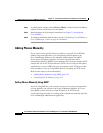
2-5
Cisco IP Phone Administration Guide for Cisco CallManager 3.2, Cisco IP Phones 7960/7940/7910
78-10453-04
Chapter 2 Preparing to Install the Cisco IP Phone on Your Network
Understanding the Phone Startup Process
Accessing TFTP Server
In addition to assigning an IP address, the DHCP server also directs the
Cisco IP Phone to a TFTP Server. If the phone has a statically defined IP address,
you must configure the TFTP server locally on the phone; the phone then goes to
the TFTP server directly.
Requesting the Configuration File
The TFTP server has configuration files (.cnf file format) for telephony devices,
which define parameters for connecting to Cisco CallManager. In general, any
time you make a change in Cisco CallManager that requires the phone (device) to
be reset, a change has been made to the phone's configuration file.
If a phone has an XML-compatible load, it requests a .XMLDefault.cnf.xml
format configuration file; otherwise, it requests a .cnf file.
If you have enabled auto-registration in Cisco CallManager, the phones access a
default configuration file (sepdefault.cnf.xml) from the TFTP server. If you have
manually entered the phones into the Cisco CallManager database, the phone
accesses a .cnf.xml file corresponding to its device name.
The .cnf.xml file also contains the information telling the phone which image load
it should be running. If this image load differs from the one currently loaded on
the phone, the phone contacts the TFTP server to request the new image file,
which is stored as a .bin file.
Contacting Cisco CallManager
The configuration file defines how the Cisco IP Phone communicates with
Cisco CallManager. After obtaining the file from the TFTP server, the phone next
attempts to make a TCP connection to the highest priority Cisco CallManager on
the list.
If the phone was manually added to the database, Cisco CallManager identifies
the phone. If the phone was not manually added to the database and
auto-registration is enabled in Cisco CallManager, the phone attempts to
auto-register itself in the Cisco CallManager database.


















